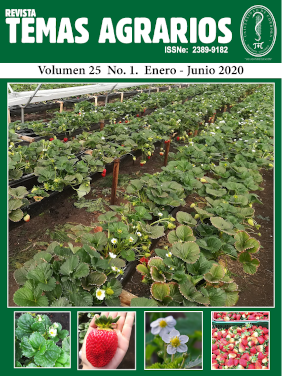Characterization of Silvopastoral Systems in the livestock basin of Molinopampa, Northwestern Zone of Peru
Caracterización de Sistemas Silvopastoriles en la cuenca ganadera de Molinopampa, Zona Noroccidental del Perú

This work is licensed under a Creative Commons Attribution-NonCommercial 4.0 International License.
Show authors biography
Producers in the Amazon region have been implementing Silvopastoral Systems (SPS), to counteract the effects on the soil and deterioration of the ecosystem due to the management of traditional livestock; However, the productive characteristics associated with these systems are unknown, with the objective of characterizing the SPS in the Molinopampa cattle basin. Surveys were applied to producers from 130 Agricultural Units, which were analyzed with a multivariate technique (conglomerates, Spearman's correlation and Principal Component Analysis). The cluster analysis allowed the classification of the producers into five groups, differentiated by the area of SSP that they manage, number of animals and milk production per cattle herd. The group that presented the best indicators was the fourth, who are dedicated to livestock in 57%, have an area greater than 6 ha, have more than 51 head of cattle and have a milk production of 70 liters / herd /day. The principal component analysis showed positive correlations between the variables of knowledge and training, total land area and system design, tree species and main activity, tree species and system design, tree preference and knowledge. Multivariate analysis techniques allowed the classification of SPS, indicating that the more knowledge and training the producers receive, the development of sustainable livestock with SPS increases.
Article visits 1078 | PDF visits
Downloads
- Alejandría, C. J. 2017. Instalación de un sistema silvopastoril. https://es.scribd.com/document/351391627/Instlacion-de-Un-Sistema-Silvo-Pastorial [15 de junio de 2019].
- Betancourt, K., Ibrahim, M., Vargas, B., y Villanueva, C. 2005. Caracterización del manejo productivo de sistemas lecheros en la cuenca del río Bulbul de Matiguás, Matagalpa, Nicaragua. Livestock Research for Rural Development 17(7): 1–11.
- Braun, A., Van Dijk, S., y Grulke, M. 2016. Incremento de los Sistemas Silvopastoriles en América del Sur. https://publications.iadb.org/publications/spanish/document/Incremento-de-los-Sistemas-Silvopastoriles-en-America-del-Sur.pdf.[18 octubre 2018].
- Cronbach, L. 1951. Coefficient alpha and the internal structure of tests. Psychometrika Vol 16(3), 297–334p. https://doi.org/10.1007/BF02310555.
- Devendra, C., e Ibrahim, M. 2004. Silvopastoral Systems as a Strategy for Diversification and Productivity Enhancement from Livestock in the Tropics. https://pdfs.semanticscholar.org/c27e/6245771efa7b0062b88b6b0477c243de2e94.pdf?_ga=2.118932937.1142338067.1575343869-1550056829.1575343869 [06 junio 2019].
- Díaz, C. 2012. Caracterización y tipificación de sistemas productivos de leche bovina, en la zona central de Chile, mediante análisis multivariable. Tesis de Magister en ciencias mención Producción Animal. Universidad Austral de Chile, Chile.
- González, J. A. 2007. Caracterización y tipificación de sistemas productivos de leche en la décima región de Chile: un análisis multivariable. Tesis para optar el grado de Licenciado en Ingeniería en Alimentos. Universidad Austral de Chile, Chile.
- González, J., y Santacruz, M. (2015). Cálculo e interpretación del Alfa de Cronbach para el caso de validación de la consistencia interna de un cuestionario, con dos posibles escalas tipo Likert. Revista Publicando 2(1): 62–77.
- Guapi, R., Masaquiza, D., y Curbelo, L. (2017). Caracterización de sistemas productivos lecheros en condiciones de montaña, Parroquia Químiag, Provincia Chimborazo, Ecuador. Revista Produción Animal 29(2): 14-24.
- Hernández, R., Fernandez, C., y Baptista, M. del P. 2010. Metodología de la investigación, MgGraw Hill Educación, México D.F., p 170-183.
- MINAGRI (Ministerio de Agricultura y Riego). 2013. Resultados definitivos, IV Censo Nacional Agropecuario - 2012. Lima. https://www.agrorural.gob.pe/dmdocuments/resultados.pdf [18 junio 2019].
- MINAM (Ministerio del Ambiente). 2015. Estrategia Nacional ante el Cambio Climático. Lima. http://www.minam.gob.pe/wp-content/uploads/2015/09/ENCC-FINAL-250915-web.pdf [18 junio 2019].
- Murgueitio, E., Chara, J., Solarte, A., Uribe, F., Zapata, C., y Rivera, J. 2013. Agroforestería Pecuaria y Sistemas Silvopastoriles Intensivos (SSPi) para la adaptación ganadera al cambio climatico son sostenibilidad. Revista Colombiana de Ciencias Pecuarias, 26, 313–316.
- Navia, J., Muñoz, D., y Solarte J. 2015. Caracterización biofísica y socioeconómica de fincas ganaderas de leche en el municipio de Guachucal, Nariño. Temas agrarios Vol 20(1), 113-229p. https://doi.org/10.21897/rta.v20i1.753.
- Noguera, M., y Vélez, J. 2011. Evaluación de algunas propiedades físicas del suelo en diferentes usos. Revista de Ciencias Agrícolas, 28(1): 40–52.
- Quero, M. 2010. Confiabilidad y coeficiente Alpha de Cronbach. Telos Revista de Estudios Interdisciplinarios en Ciencias Sociales, 12(2): 248–252.
- Rivera, S., Mora, J., y Rodriguez, M. 2016. Técnicas de estadística multivariada para la tipificación de sistemas de producción pecuarios. Revista Tumbaga, 1(11): 1-19.
- Oliva, S., Leiva, S., Collazos, R., Vigo, C. y Maicelo, J. 2018. Factores que influyen en la adopción de tecnologías silvopastoriles con la especie nativa Alnus acuminata (aliso). Agrociencia Uruguay Vol 22(2), 1-9 p. http://dx.doi.org/10.31285/agro.22.2.9.
- Rocha, C., Mora, J., y Romero, J. C. 2016. Tipología de sistemas de producción en la zona rural del municipio de Ibagué, Colombia. Agronomía Mesoamericana Vol 27(2), 253-264p. https://doi.org/10.15517/am.v27i2.24360.
- Rodríguez, H., Ramirez, C., y Restrepo, F. 2015. Factores que influencian la adopción de tecnología de gestión en producción lechera. Temas agrarios 20 (1): 34-44.
- Soler, R., Peri, P. L, Bahamonde, H., Gargaglione, V., Ormaechea, S., Huertas, A. Sánchez, L., Lorenzo, C., Martínez, G. 2018. Evaluación de la producción de conocimiento para sistemas agrosilvopastorales en América del Sur. Rangeland Ecology & Management Vol 71(5), 637-645p. https://doi.org/10.1016/j.rama.2017.12.006.
- Vargas, B., Solís, S., Sáenz, F., y León, H. 2013. Caracterización y clasificación de hatos lecheros en Costa Rica, Mediante análisis multivariado. Agronomía Mesoamericana 24(2): 257–275.
- Vásquez, H. 2016. Influencia de factores socioeconómicos en la adopción de tecnologías para el mejoramiento genético de ganado vacuno, Distrito Florida, Amazonas, Perú. Tesis de Maestría en Innovación Agraria para el Desarrollo Rural, Universidad Nacional Agraria La Molina, Lima.
- Velázquez, J. y Perezgrovas, R. 2017. Caracterización de sistemas productivos de Ganado bovino en la región indígena XIV Tulijá-Tseltal-Chol, Chiapas, México. Revista Agrociencia 51: 285-297.
- Verdezoto, H., y Viera, J. 2018. Caracterización de Sistemas de Producción Agropecuarios en el proyecto de riego Guarguallá-Licto, cantón Riobamba, provincia de Chimborazo. Ciencias Agrarias Vol 11(1), 45–53p. https://doi.org/10.18779/cyt.v11i1.198.
- Zapata, G., Bautista, F., y Astier, M. 2009. Caracterización forrajera de un sistema silvopastoril de vegetación secundaria con base en la aptitud de suelo. Técnica Pecuaria en México 47(3): 257–270.




















